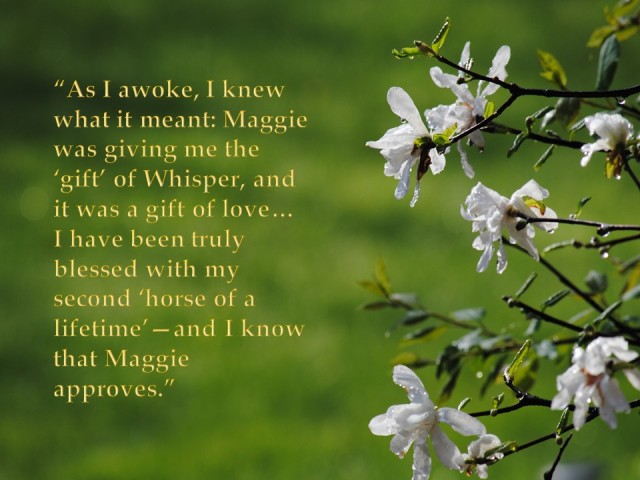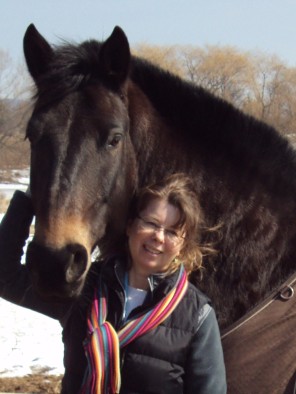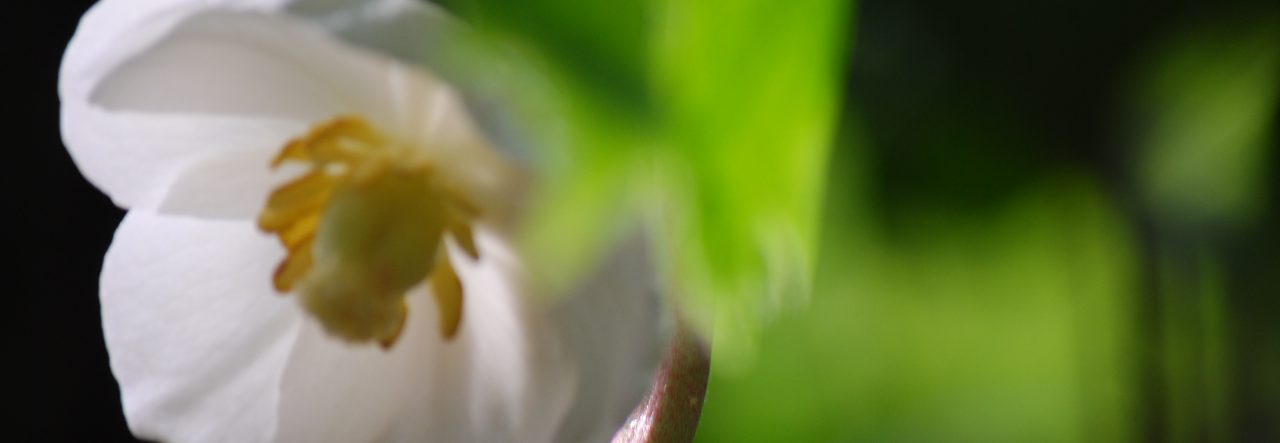
This post first appeared on The Power of Pets website maintained by Marybeth Haines.
By Ruth Edgett
Sometimes in the world of humans and horses—if we’re lucky enough—we meet our horse of a lifetime. Ubetcha Maggie was that horse for me. I felt eternally twelve years old with her. Together we could run faster, go farther, have more adventures than either of us could ever do on our own.
Having begun life as a Thoroughbred racehorse, Maggie was 1,000 pounds of compressed energy, ready to explode at the least provocation. And she was my best friend. My road with Maggie, from timid purchaser to confident rider, had taken some bumps and curves but eight years into our relationship, Maggie and I had become a well-synchronized pair; we trusted each other absolutely. Maggie would even come to me in dreams. Once, as we were still sorting our relationship and I was learning a painful new meaning for the term “On again, off again”, Maggie appeared in a dream to say proudly, “I’m very fit!” to which I replied ruefully, “I know.”
Through dreams and inner experiences, I gradually realized that Maggie’s and my story may have had its start long before we met in this life. Perhaps we had been together in previous lives, too, and this one was a chance for two souls who loved each other to be together once again. It was that kind of love that saw us through Maggie’s last days, because I had a knowing that in this life—perhaps unlike past ones—it was my job to see her out. And I did. I was there the frigid January midnight that Maggie drew her last breaths and collapsed on the floor of her stall after a valiant battle with pneumonia.
With the physical part of Maggie gone, I felt like taking a rest from horses. Responsibility for another horse, and all the commitment and expense that entailed was not something I wanted to jump right back into. Yet, friends convinced me to continue riding, and there were lots of horses who needed riders. In fact, one lived right next door.
A family had moved into the horse farm nearby only the year previously. By the time of Maggie’s death, my new neighbour—we’ll call her Alice—had bought a horse for herself but learned through painful trial and error that Whisper was not for her. In the spring following Maggie’s passage, Alice offered to let me ride Whisper occasionally.
She was an entirely different type of horse than Maggie. Where Maggie was sleek and elegant, Whisper was big-boned and solid; where Maggie was excitable and explosive, Whisper was sensible and moved with deliberation; where riding Maggie felt a like floating, I could feel every jarring step Whisper took. Still, my first time on Whisper’s back felt right. It seemed as though she was asking, “how can I work with you to make our ride a good one?” Eventually, my friends began to comment on how well Whisper and I got along. I would respond, “She’s not Maggie, but she’s a good horse.”
One day, as I was grooming Whisper after a ride with Alice, we fell into a conversation. She loved Whisper very much but knew she would never feel confident enough to ride her again. Also, she felt Whisper was too fine a horse to be left standing in the pasture for the rest of her life. Although it hurt to give her up, she knew Whisper needed another owner. Alice said she’d talked it over with her husband and, “We’d almost be willing to give her to you,” she said. “A case of beer and a Toonie would probably do it.”
As she said this, I could feel a kind of silent pull from Whisper, as though she was pleading, “Please be my person…”
Still, I told Alice, “It’s too soon since Maggie. I need time.”
Soon after that conversation, I had a dream. I was in a pasture with all of Alice’s horses and someone was handing out treats, which the horses were taking turns to accept. I was standing beside Whisper, but Maggie was there, too. When it came time for Maggie to take her treat, she stepped forward like the others. But, instead of eating the gift she was given, she brought it to me. I remember thinking inside the dream, “How beautiful that she’s giving me this treat. It’s because she loves me.”
As I awoke, I knew what it meant: Maggie was giving me the “gift” of Whisper, and it was a gift of love. Soon after that, I delivered a case of beer and a two-dollar coin to Alice in exchange for Whisper’s bill of sale. That was eight years ago. Whisper is not Maggie, but I do not want her to be. Whisper is Whisper and what a wonderful partner she is. Together we run faster, go farther, and have more adventures than either of us could ever do on our own. I know, now, that I have been truly blessed with my second “horse of a lifetime”—and I know that Maggie approves.



